- +1 330 972 2518
- info@cavescience.com
- University of Akron, 185 E
"After 30 years, I have no idea how many caves I've visited, or how many miles of new cave I've explored, but I do know that a combination of both the cave and scientific exploration is what has allowed our research to be so successful"
Hazel A. Barton, 2018
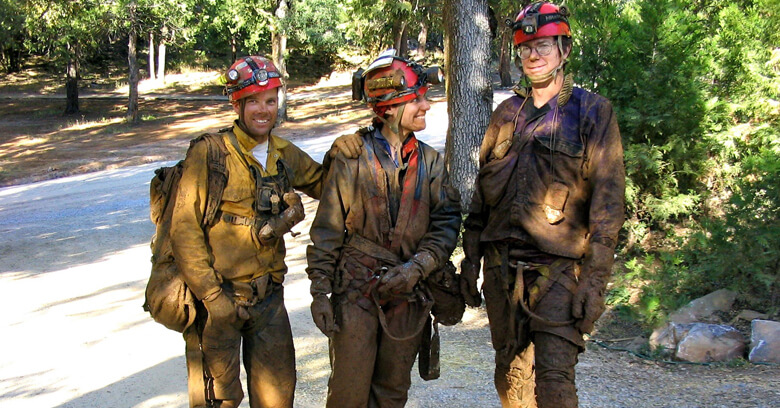
I get asked a lot about how to become a caver. I was fortunate enough to just wander into it as a teenager - at 14 I did an Outward Bound course in the UK that involved caving and, despite being a timid, city girl with essentially no outdoors training, I immediately fell in love with the climbing, squeezing and mystery of the place. Later, in Sixth Form college a teacher, Jim Moon (a past president of the Wessex Cave Club), decided to teach caving as a sports elective. Every Wednesday afternoon six students would plie in the school minivan, to go climb around the caves of the Mendip Hills, returning smelly, wet and often covered in mud. I loved it. My mum was in disbelief.
Unlike almost all other opportunities for exploration, caving needs only a helmet, lights and old clothes. Caves are primarily found in limestone rock, although they can also be found in lava, basalts, tufa, ice, quartzite, banded iron formations, and even mud. Nonetheless, knowing where the limestone can be found is not enough - unlike mountains, cave entrances can be small and obscure. Huge, beautifully decorated cave systems are there, but they can be hard to find - you might look at a hillside and not see anything, while experienced cavers might know of a dozen entrances. To find caves you therefore need the help of cavers, who can also show you the techniques necessary to remain safe underground (after all, they are the ones that will have to come get you if something goes wrong, and it’s just a lot less work to just show you how to do it right).
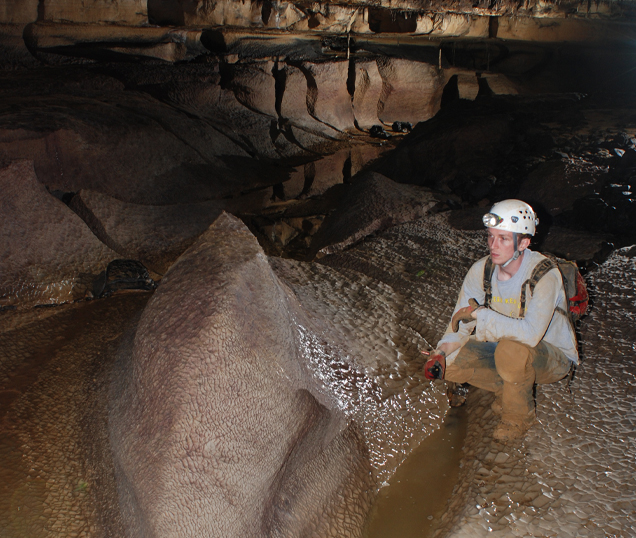 Undergraduate student Eric Banks observing the passage morphology from flooding events in SSS Cave, Kentucky.
Undergraduate student Eric Banks observing the passage morphology from flooding events in SSS Cave, Kentucky.
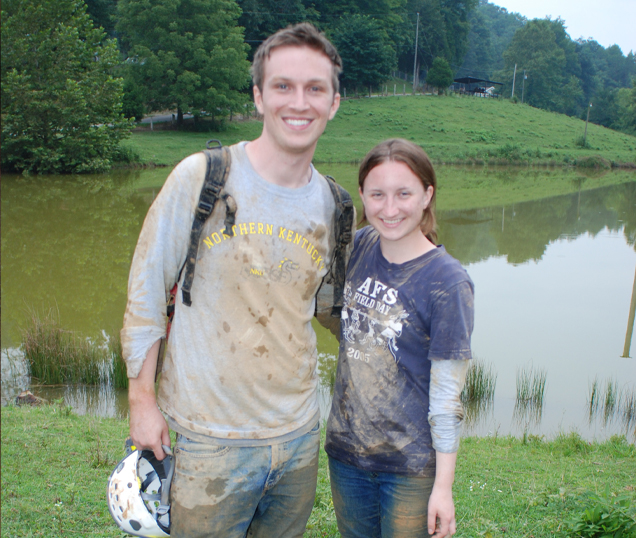 Undergraduate student Eric Banks and Masters student Melissa Thomas after a caving trip in SSS Cave, Kentucky.
Undergraduate student Eric Banks and Masters student Melissa Thomas after a caving trip in SSS Cave, Kentucky.
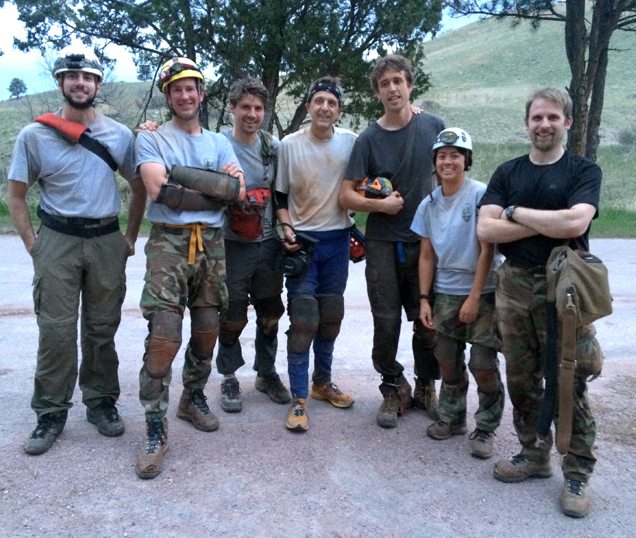 Cavers and film crew following a caving trip to the lakes deep underground in Wind Cave for the the Al Jazeera episode of 'The Cure', Wind Cave National Park, South Dakota.
Cavers and film crew following a caving trip to the lakes deep underground in Wind Cave for the the Al Jazeera episode of 'The Cure', Wind Cave National Park, South Dakota.
The need to gain trust from more experienced cavers to show you these caves is perhaps the only barrier to entry, and can require perseverance - you can’t expect to show up to your first caving club meeting and be given directions (and often gate keys) to the best caves. You need to demonstrate a willingness to listen and learn, carrying out an apprenticeship with those more experienced. If you expect this kind of trust to develop in a few weeks, then you probably won’t succeed. Alternatively, if you believe you have so much to offer you deserve to get this information immediately, then you aren’t the kind of team player that makes a good caver, and thanks, but we’re not interested.
It's important to remember that caving clubs are not there to provide a service to those who want to go into a cave - most may lead only two or three novice trips a year. This may not translate to opportunities to cave on a regular basis - you have to find those yourself. Ask for directions, maps or even volunteer on projects; people always need help looking for caves (ridgewalking), mapping, digging or on conservation projects. There will plenty of those throughout the year. By joining a club, you can learn from people how to cave safely:
If you're interested in trying caving to see if you enjoy it, I recommend taking a spelunking tour. Almost all the commercial caves within the US provide some type of tour, and they'll provide you with all the equipment, along with a knowledgeable guide. Information on tourist caves within the US can be found at the National Caves Association.
Very often, the guides on these spelunking tours are experienced cavers themselves, and they can be a huge resource for information for beginners. The major US caving organization, the National Speleological Society, also has lots of resources for beginners. Almost every major metropolitan area in the US has a caving club (even if you might be hundreds of miles from the nearest cave), and joining one of these clubs (Grottos) is your best route into cave exploration.
Within the UK, the British Caving Association and affiliated British Cave Research Association also have a lot of resources for cavers.
Outside of the US and UK, information can be found on the caving organizations of over 100 countries through the International Union of Speleology, including links to all of the national organizations in each country.
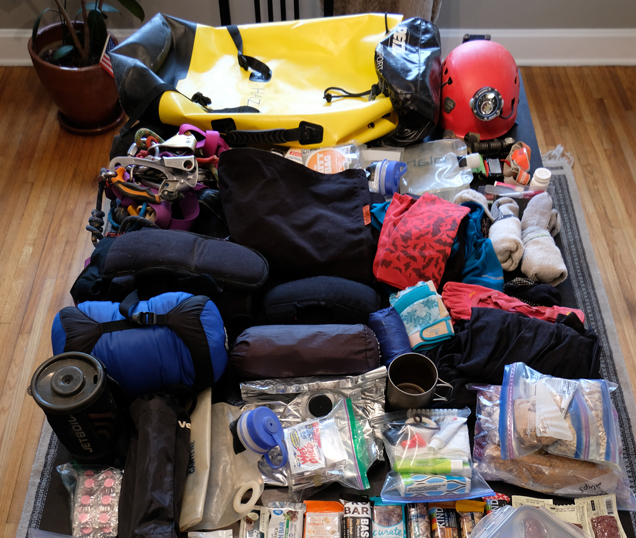 The food, caving and camping equipment that Hazel Barton took with her for a five day science trip into Lechuguilla Cave, New Mexico.
The food, caving and camping equipment that Hazel Barton took with her for a five day science trip into Lechuguilla Cave, New Mexico.
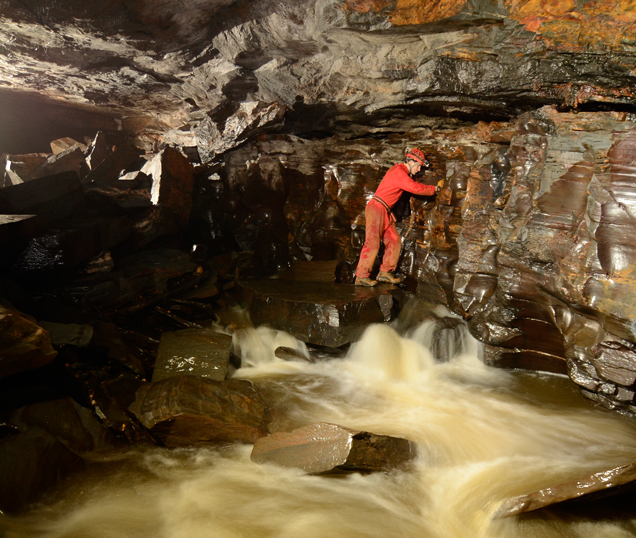 PhD student Ceth Parker exploring a river cave at a quartzite/banded iron formation contact zone in the jungles of Brazil.
PhD student Ceth Parker exploring a river cave at a quartzite/banded iron formation contact zone in the jungles of Brazil.
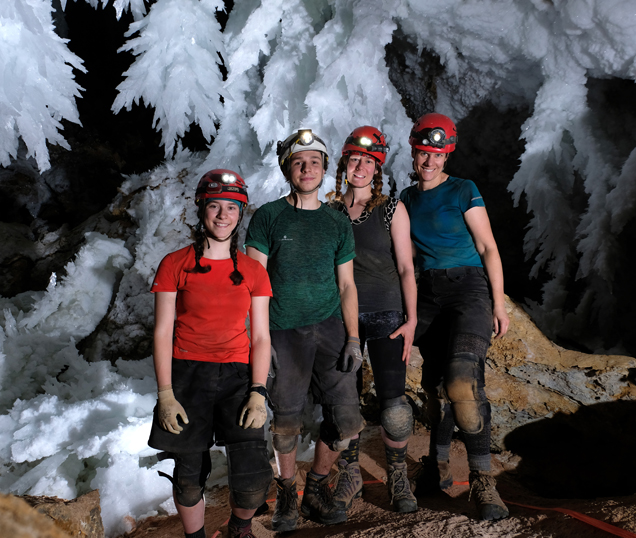 From L to R, PhD students Katey Bender and George Breley, Dr. Johanna Kovarik and Hazel Barton in the Chandelier Ballroom during a research expedition in Lechuguilla Cave.
From L to R, PhD students Katey Bender and George Breley, Dr. Johanna Kovarik and Hazel Barton in the Chandelier Ballroom during a research expedition in Lechuguilla Cave.
There are as many variations on equipment as there are ways of caving: hot, cold, vertical, horizontal, wet, sporting (i.e. really wet, like drowny-wet) and underwater. There are some specialized caving vendors, but I always like the service from Inner Mountain Outfitters. They've been super-helpful, especially when I've realized I've forgotten something for an expedition and they drop-ship it to me overnight.
The least you'll need is a good helmet.
Petzl make a good range of UIAA and CE certified climbing helmets. In the past I've had people tell me that they are "…great climbers and don't need a helmet." There are two problems with this: 1) there are ceilings in caves, and there's a good chance even the best caver would bonk themselves hard enough to hurt without one; and 2) you need something to attach your light to - straps work OK, but if you're working in a cave hard enough, you probably want the light bolted to something. I use older Petzl Ecrin helmets (no longer available), but a lot of my colleagues like the Petzl Alveo, or if you'll be caving somewhere hot, the Petzl Alveo Vent.
The next piece of essential equipment is the light.
You can spend $100 for a light that will work well in a cave. Again, Petzl make a range of lights, although I've found that they don't seem to compete with other brands at the lower end of the price range, such as Black Diamond. These lights typically run on AA batteries and can give you 4 - 8 hours of light per set of batteries, depending on how conservative you are (experienced cavers will often travel on the lowest light setting to cave, and almost always turn their lights to low or off when not moving). If you're getting into some serious caving, you might want to invest is a Sten Light or similar ($300+). These lights run on a re-chargeable battery pack about the size of two AA batteries and can easily last for 3 - 4 days underground. The next step up ($400-500) are the El Speleo headlight (often called the poor man's Scurion). These are the lights I use and have a lot more output (up to 1100 lumens) with 10 different light settings and can again provide 3 - 4 days of light underground; however, if you've serious about caving and want the best output (up to 1,500 lumens) light color, weight, battery life and durability, then you want the Scurion ($700+).
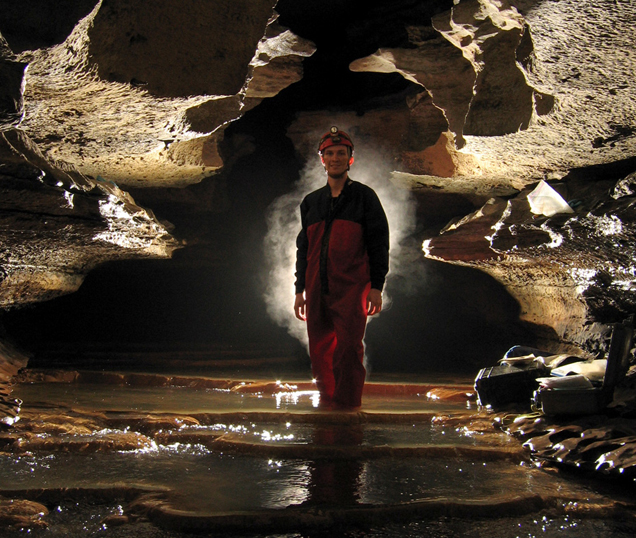 Undergraduate student Eric Banks during a sample collection trip in Grayson Gunner Cave, Kentucky.
Undergraduate student Eric Banks during a sample collection trip in Grayson Gunner Cave, Kentucky.
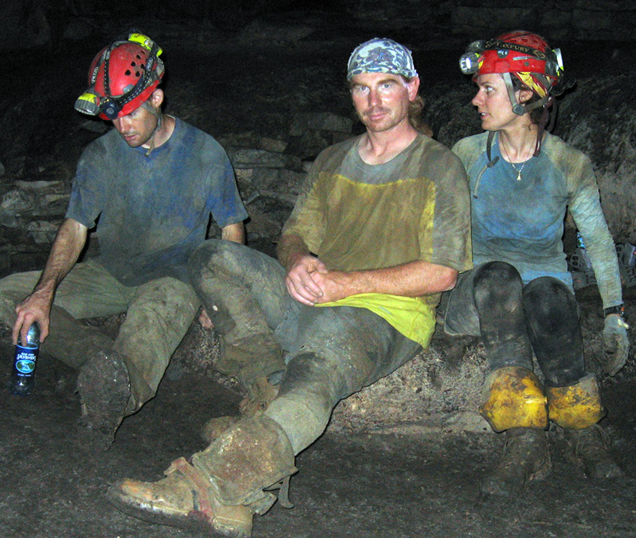 L to R, Brandon Kowalis, Paul Burger and Hazel Barton after a long (20 hour) cave rescue in Naj Tunich Cave, Guatemala.
L to R, Brandon Kowalis, Paul Burger and Hazel Barton after a long (20 hour) cave rescue in Naj Tunich Cave, Guatemala.
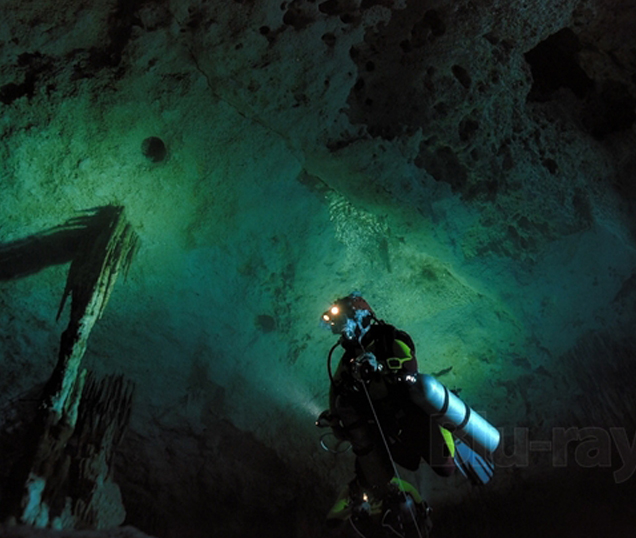 Hazel Barton diving in Dos Ojos Cave, Mexico.
Hazel Barton diving in Dos Ojos Cave, Mexico.
Clothing is going to depend a lot on where you cave. If you are in warm desert caves, then you might only use running shorts and a T-shirt, while wet alpine caves require a plastic oversuit, fleece undersuit, and thermals (along with often a wooly hat and thick gloves); however, if you're starting, then jeans and a sweatshirt that you are willing to trash are fine, until you find the right equipment for the types of caves you are exploring (something you see quite commonly in the US are cotton coveralls - these are a terrible idea, as they have no thermal insulation, get heavy when wet, and more importantly, when you're trying it climb, the crotch pulls against your arms, making it hard to reach for things). IMO sells a variety of oversuits, but I prefer the British Warbac suits, just for comfort and durability (quite stylish too). Warmbac have a really nice selection of fleece suits to insulate you in cold caves as well.
Descent Magazine is a British caving publication that, while it focuses on activities within the US, covers caving activities worldwide. It is the go-to publication for information on recent expeditions and discoveries. The publisher, Wild Places Publishing, also specializes in other cave related publications.
I also recommend checking out Derek Bristol's YouTube channel, which has a variety of videos on everything, from caving techniques to gear reviews and short documentaries on expeditions. It's a great resource for both interested beginners up to some fairly technical specifics on electronic surveying.
Speleobooks specialize in cave-related books and publications, along with jewelry, art, calendars, toys and practically anything with a bat printed on it.
The Karst Waters Institute (KWI) is an organization dedicated to improving understanding of subterranean water movement through soluble rocks (karst), which is primarily interested in soluble, limestone environments rich in caves.
The National Cave and Karst Research Institute (NCKRI) has been promoting cave and karst science for 30 years. Located in Carlsbad, NM, near Carlsbad Caverns and Lechuguilla Cave, NCKRI provides a nexus for cave research and education within the US.
The National Cave Rescue Commission (NCRC) provides hands-on training in cave rescue techniques and its members are often involved in most significant cave rescue events.
The British Cave Rescue organization is a similar institution within the UK, with active groups that coordinate and carry out most of the cave rescue functions within the UK, including coordinating the most recent Thai cave rescue.
The NSS Cave Diving Section (CDS) is an organization affiliated with the NSS that specializes in cave diving training and safety.
The BCA held a celebration of 50 years of cave exploration at the Royal Georgraphic Society. Links to the 44 presentations on all aspects of caving in the UK and overseas can be seen here.
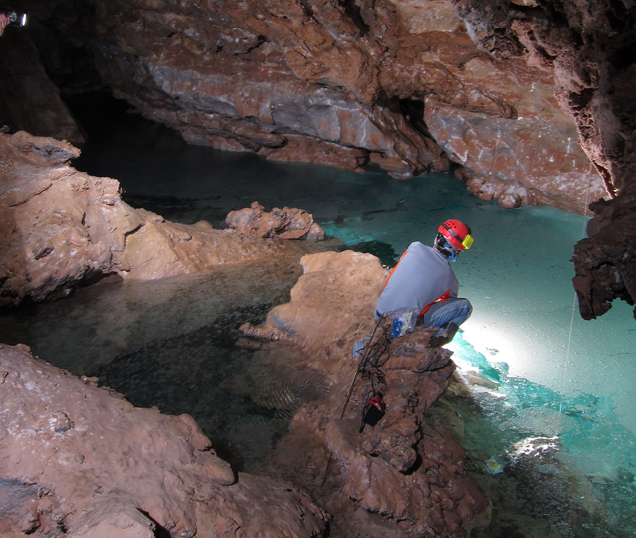 Undergraduate student Andrew Wallace samples Calcite Lake, over 700 feet underground and miles from the entrance of Wind Cave, Wind Cave National Park, South Dakota.
Undergraduate student Andrew Wallace samples Calcite Lake, over 700 feet underground and miles from the entrance of Wind Cave, Wind Cave National Park, South Dakota.
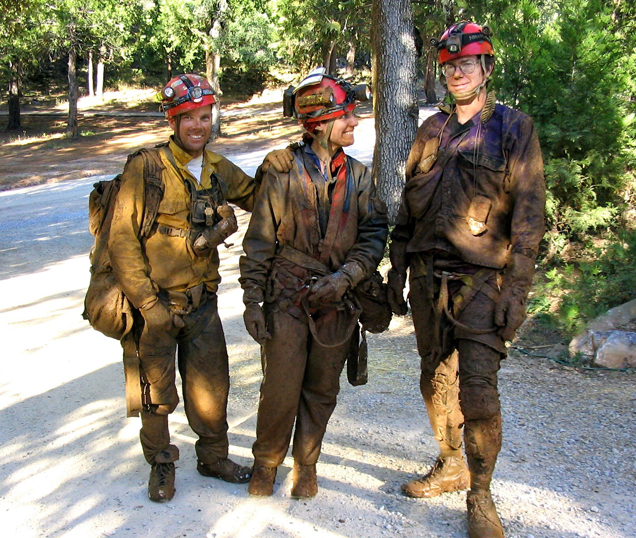 L to R, Greg Francek, Hazel Barton and Dave Bunnell, after a very muddy trip mapping Black Chasm Cave, California (you can see the paper map tucked into the only clean place on Hazel’s helmet).
L to R, Greg Francek, Hazel Barton and Dave Bunnell, after a very muddy trip mapping Black Chasm Cave, California (you can see the paper map tucked into the only clean place on Hazel’s helmet).
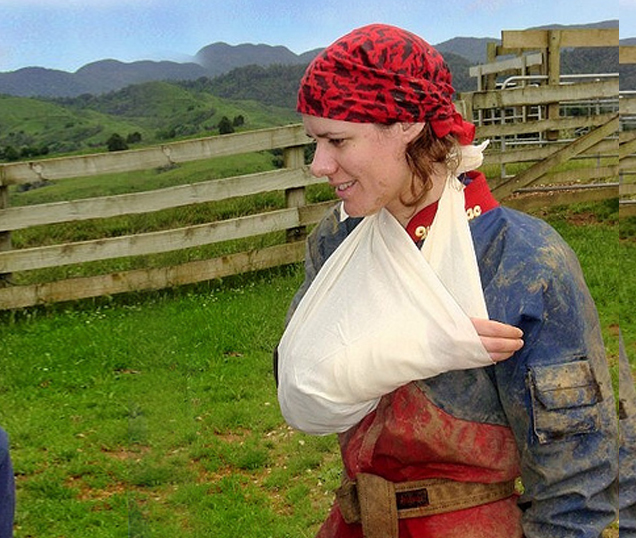 Hazel Barton following a major accident in Pukatiti Flower Cave, New Zealand (Hazel had surgery after this photo was taken, spending 3 days in hospital and 3 months of physical therapy, after a large boulder she was standing on smashed into a wall).
Hazel Barton following a major accident in Pukatiti Flower Cave, New Zealand (Hazel had surgery after this photo was taken, spending 3 days in hospital and 3 months of physical therapy, after a large boulder she was standing on smashed into a wall).
